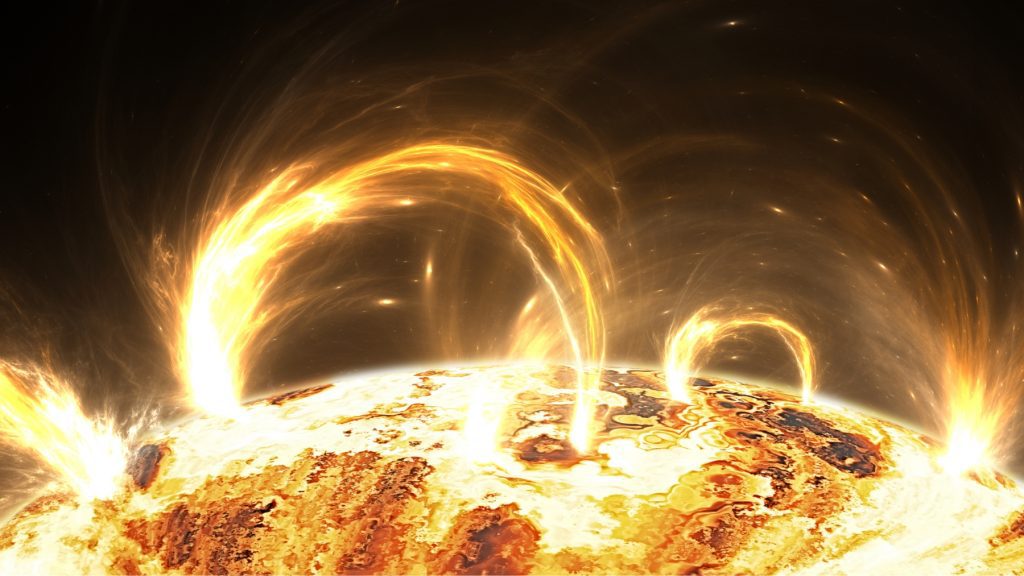
A powerful eruption on the Sun’s giant sunspot AR3363 caused a massive solar flare, resulting in a radiation surge towards Earth and triggering a radiation storm in the upper latitudes of our planet.
- Solar activity increases as the Sun approaches its solar maximum.
- The recent solar event unleashed an M6-class solar flare, disrupting radio communications, GPS signals, and satellite operations on Earth.
- Space weather monitoring agencies like NOAA play a vital role in providing alerts and information to mitigate potential disruptions caused by solar events.
On July 18th, Sunspot AR3363, in a powerful eruption on the Sun, caused a massive solar flare that sent a radiation surge towards Earth, triggering a radiation storm in the upper latitudes of the planet. The giant sunspot eruption, while not classified as an X-class flare, was still more intense than many X-flares, leading to disruptions in radio communications, GPS signals, and satellite operations.
Solar flares are powerful eruptions of energy on the Sun’s surface that release intense bursts of radiation and particles. As the Sun approached its solar maximum, the peak of its 11-year solar cycle, solar activity increased, resulting in more frequent and intense solar flares. These flares are associated with giant sunspots, temporary regions of strong magnetic fields, which become more abundant on the Sun’s surface during this period.
The recent solar event unleashed an M6-class solar flare, which was categorized as a moderately strong eruption with the potential to affect Earth’s radio communication and navigation systems. Although not an X-class flare, this eruption was substantial enough to cause a radiation storm in the upper latitudes of our planet.
NASA’s Solar Dynamics Observatory (SDO) captured the entire event as it unfolded near the Sun’s southwestern limb. During a solar flare, the Sun releases a burst of electromagnetic radiation, including X-rays, ultraviolet rays, and a stream of charged particles known as a coronal mass ejection (CME).
Dr. Sarah Miller, an astrophysicist at the Spaceweather Research Institute, emphasized the importance of monitoring solar flares during the solar maximum.
“As we approach the solar maximum, the potential for more intense solar flares and radiation storms increases. Understanding these events is crucial for protecting critical infrastructure and ensuring the safety of human activities on Earth and in space,” she said.
Geomagnetic storms, triggered by solar events like CME impacts, can have implications for Earth’s atmosphere and technology. They can disrupt radio communications, GPS signals, and satellite operations. Additionally, they can pose a risk to astronauts and high-altitude airline crews, potentially affecting ground power grids.
The US-based National Oceanic and Atmospheric Administration (NOAA), along with other space weather monitoring agencies, plays a crucial role in providing timely alerts and information to mitigate potential disruptions caused by solar events.
Cannibal CMEs, formed when a second, faster CME engulfs an initial one, are relatively rare but become more likely during the solar maximum. They are associated with the chaotic peak of the Sun’s roughly 11-year solar cycle, marked by increased giant sunspot and solar flare activity. Researchers have observed several cannibal CMEs in recent years, indicating that the solar maximum is approaching.
Russian scientists from the Fedorov Institute of Applied Geophysics in Moscow have warned of powerful solar flare activity on Monday, forecasting possible class X flares, including proton flares, which may interfere with short-wave communications. X-class flares are the largest explosions in the solar system, capable of creating long-lasting radiation storms. Proton flares are storms of solar energetic particles, composed chiefly of protons.
As we increasingly rely on space-based technologies and explore space further, accurate space weather forecasting becomes crucial for safeguarding vital infrastructure and minimizing disruptions caused by space weather events.
Inside Telecom provides you with an extensive list of content covering all aspects of the tech industry. Keep an eye on our Tech sections to stay informed and up-to-date with our daily articles.